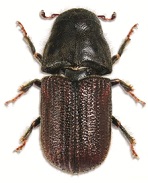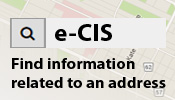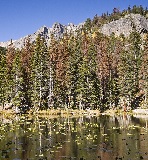Holiday season – View holiday hours for City of Winnipeg facilities and services from December 24 to January 1.
Mountain Pine Beetle
How can I control mountain pine beetles?
The mountain pine beetle (Dendroctonus ponderosae) is a small, dark-coloured, cylindrical beetle, about the size of a grain of rice. It attacks and kills standing, living, lodgepole pine trees. It generally completes its life cycle in one year. In mid-summer, large numbers of adult female beetles attack new trees by boring through the bark to the sapwood. They construct vertical galleries in the phloem between the bark and the sapwood where, after the males join them, they mate and the females deposit their eggs.
These eggs hatch into legless larvae that feed outwards from the vertical galleries on the phloem tissue of the host tree. The larvae continue their development under the bark over winter, turn into a transformation stage called pupae next spring, and finally emerge to fly and attack new host trees in the summer following the initial attack. The beetle also thrives under warm weather conditions.
The interior of British Columbia has an abundance of mature lodgepole pine, and has experienced several consecutive mild winters and drought-like summers. Beetle populations in many parts of interior B.C. have increased to epidemic levels as a result. The Mountain Pine Beetle has began to move into Alberta and could have serious ramifications in the forest industry if it continues moving east into Saskatchewan and Manitoba.
What does the mountain pine beetle look like?

The mountain pine beetle (Dendroctonus ponderosae) is a species of bark beetle native to the forests of western North America from Mexico to central British Columbia. It has a hard black shell and measures about 5 millimetres.
What does mountain pine beetle damage look like?
The beetles kill the trees by boring through the bark into the phloem layer on which they feed and in which eggs are laid. Pioneer female beetles initiate attacks, and produce pheromones which attract other beetles and results in mass attack. The trees respond to attack by increasing their resin output in order to discourage or kill the beetles, but the beetles carry blue stain fungi which, if established, will block the tree resin response.
Over time (usually within 2 weeks of attack), the trees are overwhelmed as the phloem layer is damaged enough to cut off the flow of water and nutrients. In the end, the trees starve to death, and the damage can be easily seen even from the air in the form of reddened needles. Entire groves of trees after an outbreak will appear reddish for this reason. Usually older trees die faster. After particularly long and hot summers mountain pine beetle population can increase dramatically which can lead to the deforestation of large areas.
How can I control mountain pine beetles?
In addition to harvesting at the leading edges of what is known as "green attack," a variety of other techniques can be used to manage infestations on a smaller scale. These techniques include:
- Pheromone baiting - luring beetles into trees that have been "baited" with a synthetic hormone that mimics the scent of a female beetle. Beetles can then be contained in a single area, where they can more easily be destroyed.
- Sanitation harvesting - removing single infested trees to control the spread of beetle populations to other areas.
- Snip and skid - removing groups of infested trees that are scattered over a large area.
- Controlled, or mosaic, burns - burning an area where infested trees are concentrated, to reduce high beetle infestations in the area or to help reduce the fire hazard in an area.
- Fall and burn - cutting (felling) and burning beetle-infested trees to prevent the spread of beetle populations to other areas. This is usually done in winter, to reduce the risk of starting forest fires.



